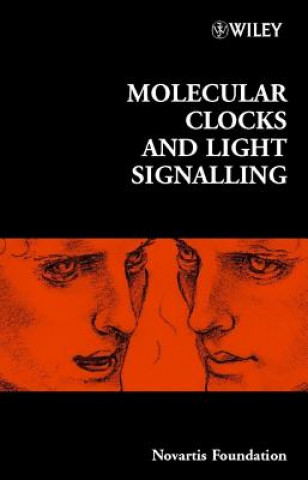
Code: 04886297
Molecular Clocks and Light Signalling
by Novartis Foundation
The ability at the molecular level to keep track of time is a property shared by organisms ranging from the simplest unicells to humans. The primary feature of these biological clocks is their ability to entrain to environmental s ... more
- Language:
 English
English - Binding: Hardback
- Number of pages: 306
Publisher: John Wiley & Sons Inc, 2003
- More about this

223.40 €
Availability:
50/50 We think title might be available. Upon your order we will do our best to get it within 6 weeks.
We think title might be available. Upon your order we will do our best to get it within 6 weeks.We search the world
You might also like
-

Who Governs the Globe?
45.68 € -

In the Evil Day
11.66 € -18 % -

Law of the Labour Market
222.09 € -

Risk-Based Auditing
196.73 € -

Reaching and Teaching All Children
32.09 € -

Napa Valley Style
42.06 € -4 % -

Malory and his European Contemporaries
114.41 €
Give this book as a present today
- Order book and choose Gift Order.
- We will send you book gift voucher at once. You can give it out to anyone.
- Book will be send to donee, nothing more to care about.
Availability alert
Enter your e-mail address and once book will be available,
we will send you a message. It's that simple.
More about Molecular Clocks and Light Signalling
You get 562 loyalty points
 Book synopsis
Book synopsis
The ability at the molecular level to keep track of time is a property shared by organisms ranging from the simplest unicells to humans. The primary feature of these biological clocks is their ability to entrain to environmental stimuli. The dominant stimulus comes from environmental light cues, which requires the existence of photopigments sensitive to light. The exact identity of the molecules involved in circadian photoreception has remained elusive. The classical view of the circadian system is of diverse physiological rhythms regulated by a centralized clock structure. This book presents evidence that challenges this view. Experiments in both vertebrate and invertebrate systems demonstrate that the circadian timing system is dispersed throughout the animal and suggest that possibly every cell contains an autonomous clock mechanism. A variety of tissues and cells contain have been shown to maintain an oscillation when placed in vitro and removed from any external cues or signals that originate from the classical clock structures and/or the environment. This book draws together contributions from an international and interdisciplinary group of experts whose work is focused on all aspects of the topic. Coverage includes the mechanisms of light signalling to the vertebrate clock, the connections between central and peripheral clocks, circadian gene expression patterns and output pathways of clock mechanisms.
 Book details
Book details
Book category Books in English Mathematics & science Biology, life sciences
223.40 €
- Full title: Molecular Clocks and Light Signalling
- Author: Novartis Foundation
- Language:
 English
English - Binding: Hardback
- Number of pages: 306
- EAN: 9780470852835
- ISBN: 0470852836
- ID: 04886297
- Publisher: John Wiley & Sons Inc
- Weight: 630 g
- Dimensions: 237 × 164 × 19 mm
- Date of publishing: 22. October 2003
Trending among others
-

Behave
21.32 € -3 % -

Behave
26.46 € -27 % -

Nutrition Support for Athletic Performance
59.16 € -18 % -

Biology: A Global Approach, Global Edition
78.99 € -9 % -

Alan Turing - The Enigma - The Book That Inspired the Film The Imitation Game - Updated Edition
10.96 € -

Biology - A Self-Teaching Guide, Third Edition
20.92 € -19 % -

Advanced Biology
63.19 € -16 % -

Blood and Its Third Element
15.79 € -7 % -

Biology for the IB MYP 4 & 5
68.62 € -

DESERT WISDOM/AGAVES and CACTI
13.68 € -24 % -

Scent and Chemistry - The Molecular World of Odors
77.68 € -11 % -

Fantastic Fungi
26.46 € -25 % -

Ecology - From Individuals to Ecosystems 5e
65.30 € -2 % -

Biology
129.91 € -

Immortal Life of Henrietta Lacks
17 € -

Molecular & Cell Biology For Dummies, 2nd Edition
17.40 € -32 % -

Biology Coloring Workbook, 2nd Edition
19.21 € -26 % -

Cartoon Guide to Biology
17.80 € -25 % -

Bovine Reproduction, 2nd Edition
304.92 € -3 % -

Campbell Biology in Focus, Global Edition
91.37 € -

Goodness Paradox
15.19 € -28 % -

Preparing Dinosaurs
83.12 € -16 % -

Biology
6.23 € -25 % -

Mitochondria and the Future of Medicine
20.22 € -28 % -

Handbook of Biological Illustration
33.90 € -

Extracellular Matrix in Development and Disease
77.18 € -13 % -

Schaum's Outline of Biology, Fifth Edition
38.73 € -10 % -

Oxford IB Diploma Programme: Biology Course Companion
62.38 € -

Oxford IB Study Guides: Biology for the IB Diploma
40.55 € -

Pearson Baccalaureate Biology Higher Level 2nd edition print and ebook bundle for the IB Diploma
90.97 € -

ISE Harper's Illustrated Biochemistry Thirty-First Edition
38.73 € -

Biology for the IB Diploma Study and Revision Guide
41.35 € -

Seven and a Half Lessons About the Brain
16.59 € -21 % -

Oxford IB Diploma Programme: IB Biology Print and Enhanced Online Course Book Pack
106.97 € -

A-Level Biology: AQA Year 1 & 2 Complete Revision & Practice with Online Edition
26.56 € -14 % -

ISE Vertebrates: Comparative Anatomy, Function, Evolution
72.05 € -5 % -

DNA
13.27 € -28 % -

Biology For Dummies 3e
17.40 € -27 % -

IB Environmental Systems and Societies Print and Online Pack
121.46 € -

Bioinformatics For Dummies 2e
23.34 € -28 % -

Molecular Ecology, Third Edition
69.23 € -6 % -

Ib Biology Online Course Book 2014 Edition: Oxford Ib Diploma Programme
96.40 € -

Dirt
24.04 € -6 % -

Internal Assessment for Biology for the IB Diploma
37.33 € -

Genius of Birds
16.49 € -13 % -

Biophilia
35.92 € -5 % -

ISE Vander's Human Physiology
77.58 € -

Microbiology & Infectious Diseases Flashcards, Third Edition
53.03 € -5 % -

A-Level Biology: AQA Year 1 & AS Exam Practice Workbook - includes Answers
7.44 € -15 %
Collection points Bratislava a 2642 dalších
Copyright ©2008-24 najlacnejsie-knihy.sk All rights reservedPrivacyCookies


 15549 collection points
15549 collection points Delivery 2.99 €
Delivery 2.99 € 02/210 210 99 (8-15.30h)
02/210 210 99 (8-15.30h)